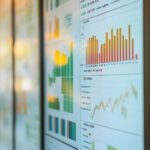Zennemis – Did you know that over 2.5 quintillion bytes of data are created every day? In today’s world, where data is key, knowing Data Analytics Terminology is vital. It helps you talk clearly and make smart choices.
Data analysis covers many areas. It goes from simple summaries to complex studies. Learning about data cleaning, visualization, and machine learning boosts your business intelligence skills.
Exploring these key concepts prepares you to find insights and solve problems. It’s crucial for tackling challenges and seizing opportunities in your career.
Understanding Data Analytics
Data analytics is key to making sense of lots of information. It helps organizations understand different data types in a clear way. This process turns raw data into useful insights that guide business strategies.
Definition of Data Analytics
Data analytics is about looking into data to find patterns and insights. It uses methods like statistical analysis and predictive modeling. This helps businesses understand past performance, find causes, predict future trends, and make smart choices.
Importance in Modern Business
Data analytics is now a must for businesses. It helps find trends, improve operations, and reduce risks. By understanding customer behavior, operational efficiency, and market trends, companies can stay ahead in the market.
Data Analytics Terminology Explained
Understanding data analytics terms is key for success in data-driven fields. Knowing the basics helps you deal with data analysis challenges. It also helps avoid common mistakes. Today, companies use these terms to find insights, predict outcomes, and suggest actions.
Key Concepts and Definitions
Data analytics includes many practices and methods. Data mining, A/B testing, and exploratory data analysis are essential. They help turn raw data into useful insights. Data cleaning and preparation are also crucial for machine learning.
It’s important to know the difference between structured and unstructured data. Structured data is easier to analyze with tools like SQL. Understanding these concepts helps you analyze data well and make strategic decisions.
Common Misunderstandings
Many people confuse data with information. Data is raw, unprocessed facts. Information comes from analyzing data to give context and insight. Not having data governance policies can also be a mistake.
Ignoring data validation can lead to wrong analyses. This can stop you from getting useful conclusions. By clearing up these misunderstandings, you can use data analytics better. This improves your analytical skills.
Types of Data Analytics
Data analytics is split into three main types: descriptive, predictive, and prescriptive. Each type offers unique insights to help organizations make smart choices.
Descriptive Analytics
Descriptive analytics looks at past data to find trends and patterns. It helps understand how your organization has performed. Techniques like data profiling and exploratory data analysis are used to see what happened and why.
Predictive Analytics
Predictive analytics uses past data to forecast future trends. It helps predict market changes and customer behavior. This gives your organization the chance to adjust strategies ahead of time.
Prescriptive Analytics
Prescriptive analytics is the most advanced type. It doesn’t just predict outcomes; it suggests actions to achieve goals. Through simulations and optimization, it recommends the best steps to take. This helps in making better decisions.
Data Mining Techniques
Data mining uses data mining techniques to find patterns in big datasets. It’s key in analysis, turning raw data into useful info. Knowing these methods helps make smart decisions.
Definition and Overview
Data mining digs out hidden patterns from big datasets. It mixes stats and machine learning to spot trends and oddities. Data discovery helps find insights, making it easier to act on them. Learning popular methods in data mining boosts your skills, guiding business strategies.
Popular Data Mining Methods
Many popular methods in data mining are known for their success. Decision Trees create models for sorting data, while k-Means Clustering groups similar data. Neural Networks handle complex data patterns with layers of nodes. These methods help businesses get deep insights from their data.
Machine Learning Algorithms
Understanding machine learning is key for making smart data choices. It’s about creating algorithms that let machines learn from data. This knowledge can help improve your business and make predictions better.
Fundamentals of Machine Learning
Machine learning algorithms can adapt and get better over time. They do this through different types like supervised, semi-supervised, unsupervised, and reinforcement learning. Supervised learning is about predicting outcomes from labeled data.
Unsupervised learning finds patterns in data without labels. It uses methods like clustering and reducing dimensions. Reinforcement learning lets an agent try different strategies to get the best results.
Common Algorithms in Use
The Naïve Bayes Classifier is a top choice for supervised learning tasks. K Means Clustering is great for unsupervised learning, grouping unlabelled data. Support Vector Machines are known for handling complex datasets well.
Linear Regression helps find relationships between continuous variables. Logistic Regression predicts the chances of an event happening. Decision Trees and Random Forests are good for both classification and regression tasks. Knowing these algorithms can help you make your business better.
Statistical Methods in Data Analysis
Statistical methods are key to good data analysis. They help us understand data better. There are two main types: descriptive and inferential statistics. Each has its own role and uses special terms to explain data.
Key Statistical Terms
Terms like mean, median, variance, and standard deviation are important. Descriptive statistics use these to summarize data. The mean shows the average, and the median is the middle value. Standard deviation helps us see how spread out the data is.
Application of Statistical Methods
Statistical methods are used in many areas. Hypothesis testing uses t-tests and ANOVA to check data conclusions. Regression analysis finds links between variables, whether they’re continuous or categorical.
Choosing the right method depends on the research goals and data type. Parametric methods assume data follows a normal distribution. Nonparametric methods work with non-continuous data. Using these methods helps professionals make better decisions with data.
Data Visualization Terminology
Understanding data visualization terms is key in today’s world. It helps show complex data in a simple way. This makes it easier for people to understand and use the data.
This process makes communication better. It helps in making decisions by making data easy to understand.
Importance of Data Visualization
Data visualization is very important. It helps find trends and patterns in data. Tools like charts and graphs make it easy to see important insights.
Using these tools makes sure your message is clear. This helps everyone understand the data better. It also helps reach business goals.
Common Visualization Tools and Techniques
Using the right tools makes your analysis better. Tools like Tableau and Power BI help create great data presentations. They offer many ways to show data, like charts and dashboards.
Choosing the right technique helps share your findings well. It makes sure your message fits your audience’s needs.
Deep Learning Concepts
Deep learning is a key part of machine learning. It uses neural networks with many layers. These algorithms mimic human thinking to find insights in huge data sets.
Every day, 2.5 quintillion bytes of data are created. This shows we need smart ways to analyze data.
Understanding Deep Learning
Deep learning is all about neural networks. These networks have neurons that work together. They use weights, biases, and activation functions to make predictions.
Unlike traditional machine learning, deep learning works well with unstructured data. It’s great for many areas, like using Convolutional Neural Networks (CNN) and Recurrent Neural Networks (RNN).
Applications of Deep Learning in Analytics
Deep learning in analytics has many uses. It helps with voice assistants and fraud detection. These are just a few examples of how AI and analytics come together.
It can also improve business processes and marketing. Plus, it helps in understanding public opinions. As we need more data-driven decisions, deep learning will lead to new solutions.
Business Intelligence Terms
Business intelligence (BI) is key to better decision-making in organizations. It gives insights from data. Knowing important BI terms helps use these insights well. Key ideas like data warehousing, ETL, and data visualization are crucial.
They shape how we work with data and use BI tools.
Overview of Business Intelligence
Recently, more sectors have started using BI techniques. Companies see the value in using data to improve operations. This has led to a big need for BI experts.
The move to make decisions based on data is a big change. Only about 20% of logistics companies use BI tools. This means there’s still a lot of room to get ahead.
Common BI Tools and Techniques
Many BI tools are leading the way, each with its own strengths. Tools like Microsoft Power BI, Tableau, and QlikView help users see data clearly. This makes it easier to find important performance indicators (KPIs).
Companies use dashboards to keep track of key metrics. Using tools that help teams work together is also becoming more common. This shows how BI techniques are changing to meet today’s business needs.
Conclusion: Data Analytics Terminology
Learning data analytics terms is key for success in today’s data-rich world. As companies make more data-driven choices, knowing these terms is crucial. It helps you understand data and use analytical methods well.
This knowledge boosts your use of business intelligence tools. It leads to better strategic decisions in your work.
The need for skilled data analysts is growing fast. With a 35% growth rate and 59,400 new jobs expected, now is the time to improve your skills. Learning about different analytics types lets you see past trends and predict the future.
Keep growing your data analytics skills. Use statistical methods and tools like SAS, Tableau, and Power BI. These tools help you work with data accurately and reliably.
By mastering these skills, you’re ready for the changing data analytics world. Keep learning and improving to stay ahead.
FAQ: Data Analytics Terminology
What is data analytics terminology?
Data analytics terminology is all about the key words and concepts we use today. It helps us talk and work with data in a business setting. Knowing these terms lets us use the right tools and methods for making smart decisions.
Why is data analysis important in modern business?
Data analysis is key in today’s business world. It helps companies spot trends, cut down risks, and use resources better. This way, businesses can make informed choices and stay ahead in a fast-changing market.
How do you differentiate data from information?
Data is raw, unprocessed facts. Information is data that has been analyzed and given meaning. Knowing the difference is vital for using data analytics well and making smart choices.
What are the main types of data analytics?
There are three main types of data analytics. Descriptive analytics looks at past data. Predictive analytics guesses what will happen next. Prescriptive analytics suggests actions to get the desired results.
What are some common data mining techniques?
Data mining uses techniques like clustering and classification. It also includes regression analysis and association rule mining. These methods help find patterns and connections in big datasets, leading to useful insights.
What is machine learning and how is it related to data analytics?
Machine learning is a part of artificial intelligence that lets systems learn from data. It makes predictions or decisions without being programmed. Its algorithms, like Linear Regression and Decision Trees, are key for making good predictive models in data analytics.
What statistical methods are commonly used in data analysis?
In data analysis, we often use mean, median, and variance. Standard deviation and hypothesis testing are also common. These methods help us understand uncertainty and draw conclusions from data.
Why is data visualization important?
Data visualization is important because it makes complex data easy to understand. It helps people see insights quickly, making it easier to make decisions based on data.
What are deep learning concepts in relation to data analytics?
Deep learning uses advanced machine learning to analyze lots of data. It’s used for things like image recognition and natural language processing. This gives us deep insights from unstructured data.
What should I know about business intelligence terms?
Business intelligence (BI) is about using tools and strategies to analyze business data. It includes data warehousing and ETL processes. Tools like Tableau and Power BI help us get insights and make strategic decisions.




